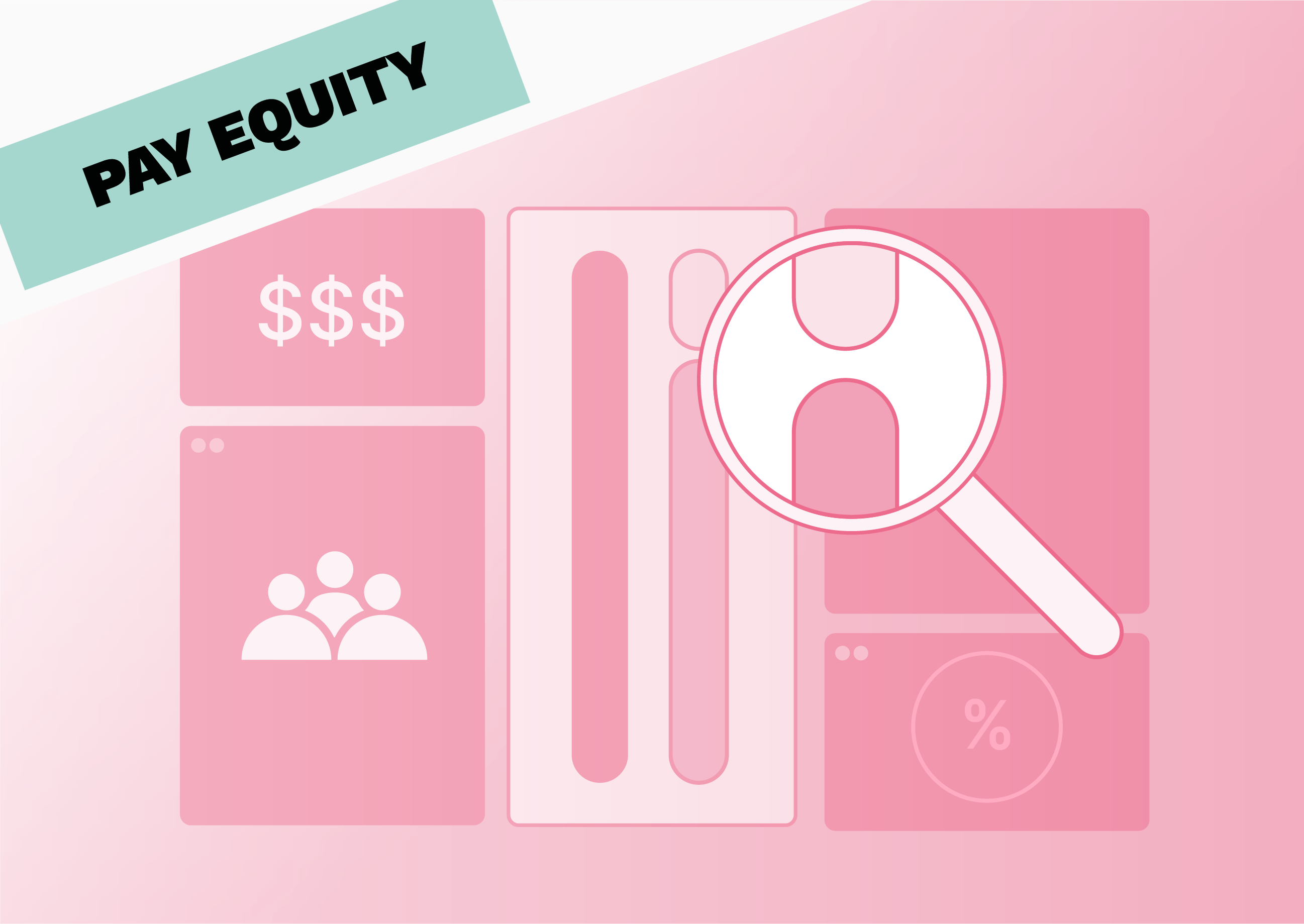The gender pay gap is a critical issue in 2025 — but it’s only one piece of a much larger puzzle. When it comes to pay equity, other factors like race, age, disability and more interact and compound with each other, meaning some women face a much wider gap than others. In this article, we'll explore how these intersecting identities shape pay equity, and why a one-size-fits-all approach isn’t enough to tackle pay discrimination.
What is intersectionality?
Each of us holds multiple social identities, including race, ethnicity, gender, age, disability status and sexual orientation. Intersectionality is the concept that these identities don’t exist in isolation. Instead, they overlap and interact, shaping how individuals experience privilege, bias and discrimination.
For example, data from the UK shows that both women and ethnic minority employees are paid less than their male or white counterparts on average. But someone who belongs to both groups — a black woman, for example — may face an even larger pay gap. The same compounding effect can be seen among disabled employees and those from the LGBTQ+ community, among others.
Put simply, not all women experience the gender pay gap in the same way. That’s why focusing your pay equity efforts on gender alone isn’t enough — a truly equitable strategy must take intersectionality into account.
Intersectional discrimination and the EU Pay Transparency Directive
The EU Pay Transparency Directive provides a clear legal basis for intersectional discrimination. While the reporting requirements focus mostly on gender, the directive also acknowledges that other factors — such as race, ethnicity, age or disability — can influence compensation outcomes.
The directive also provides a definition for intersectional discrimination, defining it as discrimination based on a combination of sex and any other characteristic mentioned in other EU directives on equality in the workplace. For example, if a black woman receives a lower salary than both her male and white female counterparts, this could be an example of intersectional discrimination unless there is a justifiable reason for the discrepancy.
5 forms of pay discrimination to look out for (other than gender)
Pay audits often reveal pay discrepancies that can’t be explained by gender alone — which could reflect underlying discrimination. Here are five other factors that could be influencing pay within your organisation.
1. Race and ethnicity
Imagine two employees working in the same role, at the same level and in the same location. The only difference between them: one is black, and the other is white. If the black employee is underpaid compared to their white counterpart, it’s likely that pay discrimination is at play.
There’s strong evidence that race intersects with the gender pay gap, meaning women of colour face even worse pay disparities than white women. For example, a 2023 report by the Fawcett Society found that the overall pay gap between men and women in the UK was 11.3% . However, this was significantly higher for women of Bangladeshi (28.4%), Pakistani (25.9%), and Mixed White and Black Caribbean (25%) backgrounds.
2. Disability
According to a paper from the International Labour Organization (ILO), working people with disabilities are paid 12% less per hour on average than other employees. Only 9% of that gap is explained by differences in education, age or type of work. Again, disability and gender can compound, meaning that disabled women are likely to experience greater pay discrimination than either non-disabled women or disabled men.
3. Age
While it’s totally reasonable to base pay on factors like an employee’s level of experience (which is often correlated with age), basing it on age itself is discriminatory. Despite this, young workers do sometimes find they are paid less than older colleagues, even when this isn’t justified by any objective factor related to their work. At the other end of the spectrum, older workers can also find themselves paid less or offered fewer opportunities than their younger counterparts.
4. Sexual orientation or gender identity
According to a 2022 report by the TUC, only one in eight companies in the UK monitor their LGBT pay gap, which research suggests may be as high as 16%. This means that LGBT employees may be receiving less pay than their straight, cisgender colleagues. Again, this is likely to compound with sex-based pay discrimination, with gay women experiencing worse discrimination than gay men.
5. Parental and family status
Women in the workplace often face what is known as the ‘motherhood penalty’, which is a reduction in earnings and career opportunities after having children. There are many reasons behind this, including childcare struggles and the fact that women still carry the lion’s share of domestic work.
This also compounds with the gender pay gap in an interesting way. Since women are already likely to be paid less than their male partners, it often makes the most financial sense for them to take time out of the workforce after having children — which can impact their pay and career progression going forward.
The leadership gap
In much of the world, leadership positions are dominated by able-bodied white men, with other groups of employees severely underrepresented. And intersectionality plays an important role here too. For example, according to McKinsey’s 2024 Women in the Workplace report, women make up just 29% of the C-Suite. However, the situation is even worse for women of colour, who hold just 7% of seats at the leadership level.
This is a bit of a self-fulfilling prophecy, because without diversity on leadership teams, organisations often fail to see different perspectives and find it difficult to create policies that address the needs of different groups of employees. For this reason, many strategies to address intersectional pay discrimination also involve improving diversity on leadership boards.
Strategies to address intersectional pay and leadership gaps
Pay equity legislation like the Pay Transparency Directive tends to focus mostly on gender equity. And there’s a good reason for this: most employers don’t collect information on factors like their employees’ race, disability status and sexual orientation. In some countries, gathering this data may even be prohibited by law.
That said, it’s also true that focusing on gender alone is not enough to combat pay discrimination. Here are some things you can do to eliminate pay disparities and ensure equal pay for work of equal value:
- Adopt clear and consistent pay structures: The best way to avoid any form of pay discrimination is to ensure pay decisions are made according to concrete, consistent criteria. That means setting up a strong job architecture, a clear job evaluation process and solid systems for compensation reviews. All of this helps ensure employees in similar job functions are paid fairly, regardless of their background.
- Conduct comprehensive pay audits: Even if you have the right intentions, pay discrepancies can still emerge. It’s important to conduct regular pay equity audits to ensure your pay is fair and consistent. Looking for patterns in pay related to characteristics like age, race, disability and other factors can help you identify and eliminate pay discrimination.
- Promote transparency: Under the Pay Transparency Directive, employers will be required to regularly publish certain statistics related to sex and compensation, including their gender pay gap. While this is a good start, the best employers will go further by sharing data on how pay breaks down by race, disability, age and other factors. This shows accountability and demonstrates your commitment to fair and equitable compensation.
- Create inclusive policies: Looking at your workplace policies through an intersectional lens can help you to make them more inclusive of different groups of employees. For example, flexible working policies can be invaluable to employees with caregiving responsibilities and those with disabilities. It’s all about considering how different groups of employees experience the workplace, and designing your policies to give everyone the same access to opportunities.
- Provide training on intersectionality: Pay disparities often arise from unconscious biases rather than deliberate discrimination. Training HR, management and leadership to identify and address their biases can help reduce their impact on pay. It’s important to deliver specific training on intersectionality — how different identities and characteristics overlap — to help everyone understand the dynamics of privilege and discrimination at play.
- Offer leadership and development opportunities: As we’ve mentioned, the lack of diversity on senior leadership teams is a big problem. And individuals holding more than one minority status are even less likely to be represented. Employers should set up mentorship and sponsorship programs and provide learning opportunities specifically to help underrepresented groups climb the ladder. This helps build diverse talent pipelines and can ultimately increase the diversity of voices on leadership boards — which can have a trickle-down impact on DEI throughout an organisation.
Why all of this matters in 2025
In 2025, many employers are striving to build fairer, more transparent workplaces. This is partially in preparation for the EU Pay Transparency Directive, which will require more transparency from employers across Europe. But the directive didn’t emerge in a vacuum — it’s a response to the changing demands of employees, who now expect greater accountability from their employers.
Employers that take an intersectional approach to DEI and pay equity are better equipped not only to comply with new legislation, but to meet the demands of their teams. This can help to boost engagement, improve talent attraction and drive retention. Companies that prioritise diversity, equity and inclusion also tend to see better financial performance and improved innovation. All of this means that DEI isn’t just the right thing to do in 2025 — it’s a business imperative.






